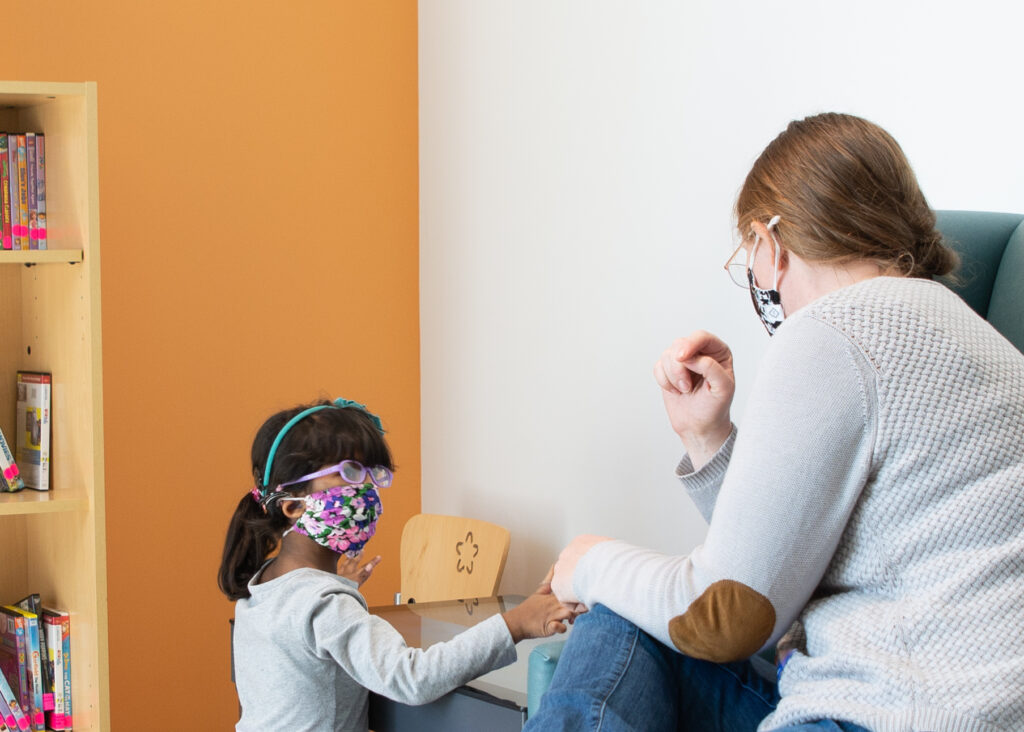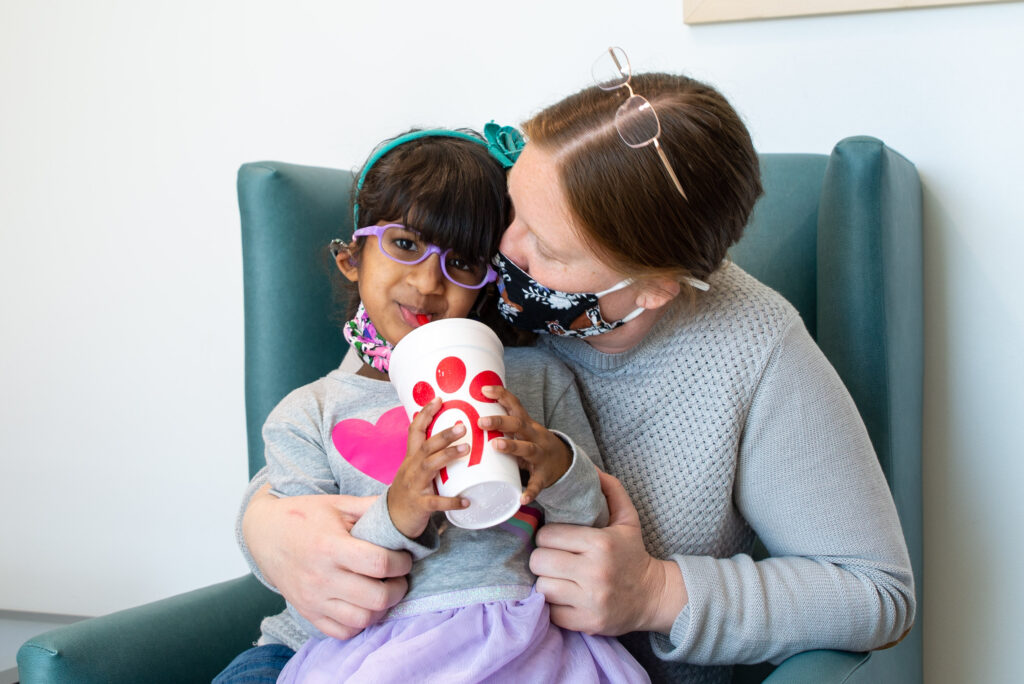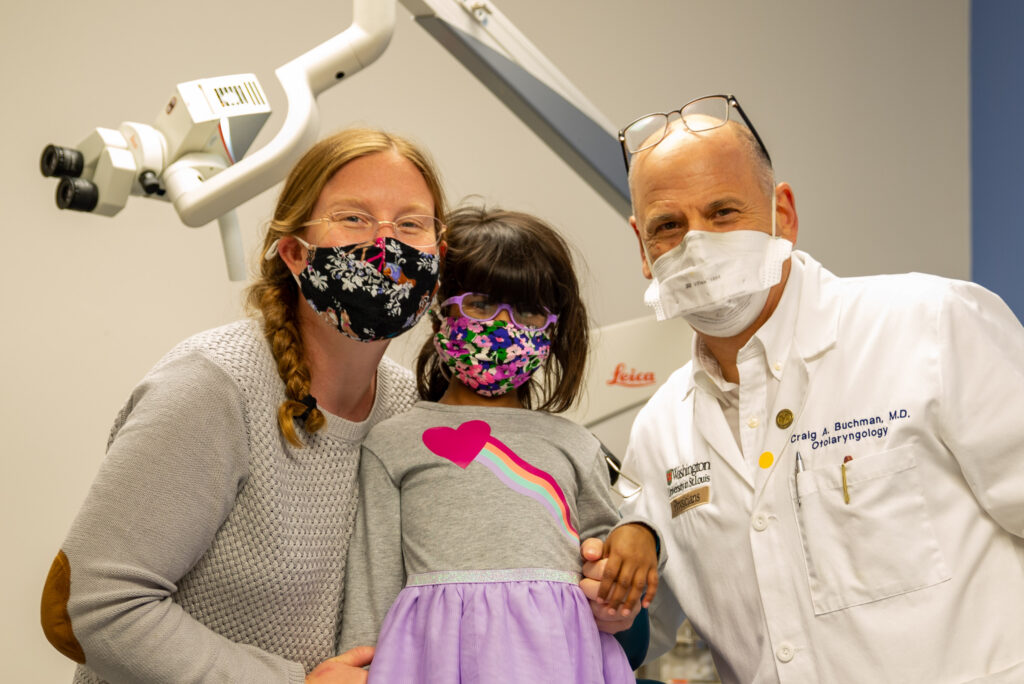Anusha Oberg is like most five-year-old children – unbridled energy and a strong desire to explore the world around her. But, Anusha is deaf. At least she was. Thanks to a procedure conducted at St. Louis Children’s Hospital, Anusha can now detect sounds.
Anusha’s new awareness of sound is made possible by an auditory brainstem implant or ABI that directly stimulates neurons of her brainstem. The procedure is an option for patients with missing or damaged inner ears or auditory nerves that would not be good candidates for a cochlear implant.
How does an auditory brainstem implant work?
An external microphone picks up sounds from the environment and transmits those signals to a receiver-stimulator implanted under the skin. The stimulator sends tiny electrical signals to electrodes placed on the brainstem. Anusha’s surgery was performed by Lindberg Professor and Chair of Otolaryngology Craig Buchman, MD, and neurosurgeons Michael Chicoine, MD, and David Limbrick, MD, PhD.
Buchman has evaluated more than 100 pediatric patients from all over the country for the procedure. In his opinion, Anusha was a great candidate because of her strong cognitive abilities.
“It’s difficult to predict the outcome because children like Anusha have never experienced hearing,” he explained. “We hope these patients gain some sound awareness.”
According to Buchman, that sound awareness can make them safer in a busy environment and can potentially aid them with lip reading.
Anusha was adopted by Jena Oberg in January 2020. She had a documented profound hearing loss, and her caregivers in India felt she was a good candidate for a cochlear implant. They believed she had some degree of hearing because of the wide range of her vocalization.

Home in Pittsburgh, it was at an appointment to assess cochlear implant candidacy that they learned Anusha had a complete lack of development of both inner ears, a condition known as Michel aplasia. She was therefore not a candidate for a cochlear implant. The auditory brainstem implant was offered as an alternative, but Jena felt her daughter was so healthy otherwise, it wasn’t worth the risk.
“After a few days, I started doing some research,” she said. “Anusha so desperately wanted to communicate using speech, I had to at least explore the ABI procedure.”
Jena was encouraged by what she read, but learned there were very few sites in the country that would perform the implant procedure on a patient like Anusha. Furthermore, the COVID pandemic was still in full swing.
“Our ENT specialist at home spoke very highly of Dr. Buchman,” she said. “He had conducted one of the first clinical trials of the device in patients like Anusha, so we decided to start our journey in St. Louis.”
A two-day drive put Jena and Anusha at St. Louis Children’s Hospital.

“When we first arrived, I was still very uncommitted to the procedure,” Jena admitted. “But after meeting with Dr. Buchman and the rest of the team, I was sold.”
In addition to Buchman, Anusha’s team includes audiologists Jamie Cadieux and Janet Vance and speech pathologist Andrea Gregg. Implant surgery was performed Oct. 19, 2020, and Anusha returned home to heal. Six weeks later she returned to Children’s Hospital for activation and programming of the implant.
As the implant was activated, it was clear right away that Anusha was aware of a new sensation. The initial activation and programming procedure lasted three hours, and it kept her attention for every minute.

In the few months since activation, she continues to show interest in her new auditory world. According to Jena, she is excited about hearing sounds and is a thriving pre-K student at Western Pennsylvania School for the Deaf.
“She is certainly more vocal since the implant was activated,” said Jena. “She is very eager to speak, and she is more aware that things have sounds, which is very cool. If she gains nothing more, it will have been worth going through the procedure to get this far.”
